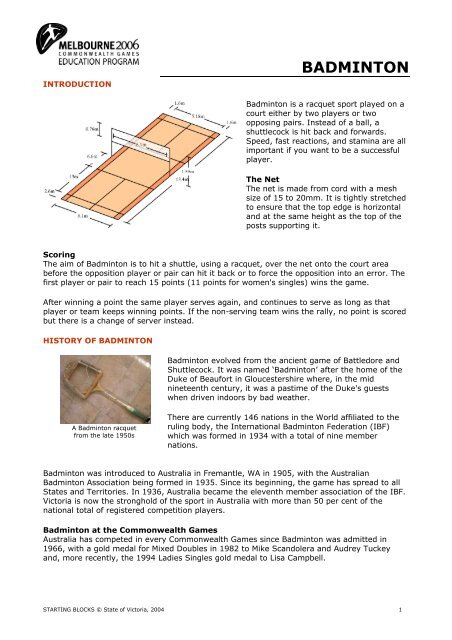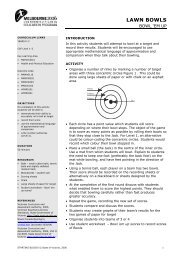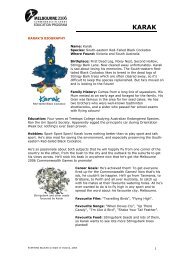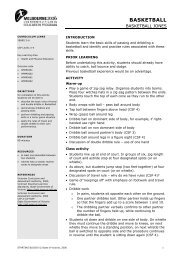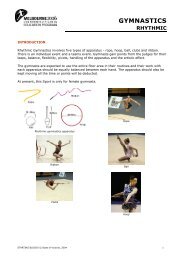badminton - Education Program
badminton - Education Program
badminton - Education Program
Create successful ePaper yourself
Turn your PDF publications into a flip-book with our unique Google optimized e-Paper software.
INTRODUCTION<br />
BADMINTON<br />
Badminton is a racquet sport played on a<br />
court either by two players or two<br />
opposing pairs. Instead of a ball, a<br />
shuttlecock is hit back and forwards.<br />
Speed, fast reactions, and stamina are all<br />
important if you want to be a successful<br />
player.<br />
The Net<br />
The net is made from cord with a mesh<br />
size of 15 to 20mm. It is tightly stretched<br />
to ensure that the top edge is horizontal<br />
and at the same height as the top of the<br />
posts supporting it.<br />
Scoring<br />
The aim of Badminton is to hit a shuttle, using a racquet, over the net onto the court area<br />
before the opposition player or pair can hit it back or to force the opposition into an error. The<br />
first player or pair to reach 15 points (11 points for women's singles) wins the game.<br />
After winning a point the same player serves again, and continues to serve as long as that<br />
player or team keeps winning points. If the non-serving team wins the rally, no point is scored<br />
but there is a change of server instead.<br />
HISTORY OF BADMINTON<br />
Badminton evolved from the ancient game of Battledore and<br />
Shuttlecock. It was named ‘Badminton’ after the home of the<br />
Duke of Beaufort in Gloucestershire where, in the mid<br />
nineteenth century, it was a pastime of the Duke's guests<br />
when driven indoors by bad weather.<br />
A Badminton racquet<br />
from the late 1950s<br />
There are currently 146 nations in the World affiliated to the<br />
ruling body, the International Badminton Federation (IBF)<br />
which was formed in 1934 with a total of nine member<br />
nations.<br />
Badminton was introduced to Australia in Fremantle, WA in 1905, with the Australian<br />
Badminton Association being formed in 1935. Since its beginning, the game has spread to all<br />
States and Territories. In 1936, Australia became the eleventh member association of the IBF.<br />
Victoria is now the stronghold of the sport in Australia with more than 50 per cent of the<br />
national total of registered competition players.<br />
Badminton at the Commonwealth Games<br />
Australia has competed in every Commonwealth Games since Badminton was admitted in<br />
1966, with a gold medal for Mixed Doubles in 1982 to Mike Scandolera and Audrey Tuckey<br />
and, more recently, the 1994 Ladies Singles gold medal to Lisa Campbell.<br />
STARTING BLOCKS © State of Victoria, 2004 1
ABOUT BADMINTON<br />
BADMINTON<br />
Badminton is played in singles, doubles and mixed teams.<br />
To score a point, the players have to hit the shuttlecock with<br />
their rackets so that it lands on their opponents court – then<br />
a point is scored.<br />
To score a point, the players have to hit the shuttlecock with<br />
their rackets so that it lands on their opponent’s court – then<br />
a point is scored.<br />
In men’s competition, the first to reach 15 points is the<br />
winner, while eleven points is enough to win a women’s<br />
match.<br />
International Women's<br />
doubles match<br />
Types of Shots<br />
1. Clear – powerful stroke that sends the shuttlecock from one<br />
end of the court to the other.<br />
2. Drop Shot – a stroke that sends the shuttlecock just above<br />
the net.<br />
3. Smash – very powerful stroke that send the shuttlecock<br />
down fast on the oppositions side of the court.<br />
4. Lift – defensive – sends the shuttlecock to the back of the<br />
opponent’s court.<br />
Smash shot<br />
5. Drive – powerful straight stroke from shoulder height<br />
STARTING BLOCKS © State of Victoria, 2004 2
BADMINTON<br />
BADMINTON EQUIPMENT<br />
Racquet<br />
The main parts of a racquet are called the handle, the stringed<br />
area, the head, the shaft, the throat and the frame.<br />
They are made of lightweight materials such as aluminium,<br />
graphite and titanium and weigh 85 to 100 grams.<br />
The frame of the racquet cannot exceed 680mm in overall length<br />
and 230mm in overall width.<br />
Racquet<br />
Shuttlecock<br />
Shuttlecocks<br />
Must have 16 feathers fixed to the base. Feather lengths can be<br />
variable from 64mm to 70mm, but in each shuttle must be that<br />
of the same size. The shuttle must weigh between 4.74 and 5.50<br />
grams.<br />
Posts<br />
Height – 1.55m from surface of the court<br />
Net<br />
Height<br />
1.524m at the centre of the court<br />
1.55m over the side lines (doubles side lines)<br />
Depth – 760mm<br />
No gaps to between the ends of the net and the posts<br />
STARTING BLOCKS © State of Victoria, 2004 3
BADMINTON<br />
BADMINTON – EVENT INFORMATION<br />
The Badminton competition is to be conducted at the<br />
Melbourne Exhibition Centre (MEC) in a purpose-built<br />
temporary facility.<br />
The Badminton facility will comprise six competition and<br />
two warm-up courts, with seating for approx 3 600<br />
spectators.<br />
The Badminton competition will be held over the entire<br />
eleven days of the Games (eleven days of competition).<br />
Events<br />
Event Male Female<br />
Singles<br />
Doubles<br />
Doubles - Mixed<br />
Teams - Mixed<br />
The 2006 Commonwealth Games competition will consist of singles, doubles and team events<br />
with a total of six gold medals to be awarded.<br />
Training will be conducted at the Altona Badminton Centre (Paisley Park).<br />
BADMINTON - DID YOU KNOW?<br />
Badminton is the world’s fastest racquet sport – the shuttlecock can reach speeds<br />
of up to 260 kilometres per hour.<br />
Badminton requires speed, agility and lightning-fast reflexes.<br />
The first Badminton racquets were made of wood. Today, materials such as<br />
aluminium, graphite and titanium are used.<br />
JOIN IN BADMINTON<br />
Badminton Australia logo<br />
Players from all ages can become involved in<br />
Badminton.<br />
A ten-week program for schools is available from<br />
Badminton Victoria (see below).<br />
To find out more about Badminton and where to take part, please contact:<br />
Badminton Victoria - www.<strong>badminton</strong>vic.com.au<br />
Phone: (03) 96864777<br />
Badminton Australia - www.<strong>badminton</strong>.org.au<br />
Phone: (03) 93974722<br />
STARTING BLOCKS © State of Victoria, 2004 4


